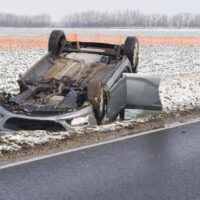How Speed Affects Rollover Accidents

Driving fast and engaging in aggressive, dangerous driving maneuvers can lead to rollover accidents. A rollover accident is a traffic crash in which at least one of the vehicles is upended, either landing with its top on the ground or rolling over back onto its wheels. Rollover accidents are incredibly dangerous, often leading to serious injury or death. Driving at high speeds is often correlated with rollover accidents, but how does speed actually factor into the likelihood or severity of a rollover accident? Read on for a discussion of speed and rollover accidents, and reach out to a seasoned New York car accident attorney if you or a family member has been injured in a car crash in the Hudson Valley.
Speed Increases the Likelihood of a Rollover
One fact is clear: driving at high speeds greatly increases the chance of a rollover accident. Vehicles colliding at low speeds, such as a fender-bender in a parking lot, are unlikely to roll over. If at least one vehicle is driving at high speeds, then it is much more likely that either vehicle will wind up rolling over (whether it is the car going at high speeds or the lower-speed car struck by the high-speed vehicle).
One study by the Federal Motor Carrier Safety Administration (FMCSA), for example, found that as many as 45% of rollover accidents involved high speeds. While speed alone will not cause a crash, it makes a rollover much more likely. Rollovers are especially likely when a driver rounds a curve at a high rate of speed, even if there is no collision. Roughly two-thirds of rollover accidents connected to speed also involve curves in the road and whether the driver takes appropriate precautions.
High Speeds + Other Factors Lead to Rollover Accidents
High speeds alone do not cause rollover accidents. Typically, high speed plays a role, but other aggravating circumstances exist as well. A number of factors are at play with any rollover accident, although crashing at high speeds certainly increases the likelihood of a rollover. Some of the factors that contribute to rollover accidents, in addition to high speed, include:
- Size of the vehicle. Large vehicles, such as semis and tractor-trailers, are much more likely to flip over than passenger vehicles. Large vehicles have a different center of gravity, and speeding around a corner with a massive load in the back is much more likely to cause the vehicle to tip than driving a sports car.
- Imbalanced loads. Large trucks are at especially high risk to tip over when they are overloaded or carrying an imbalanced load. Anything that changes the weight or size of a vehicle will affect the vehicle’s balance, and the driver must adjust for the change in order to drive safely. If a truck is overloaded, if its load is not properly secured, or if the haul is not loaded properly, then the truck is much more likely to be off-balance. The same applies to passenger vehicles with unusually heavy or awkward loads. Off-balance vehicles are likely to tip over on their own should they swerve or make a sharp turn, and they are especially likely to tip over if they collide with another vehicle.
- Inclement weather. Rain, snow, ice, wind, and fog all increase the risk of a rollover accident. Particularly when a driver is speeding and rounding curves quickly, if the road is wet or icy, a rollover accident is much more likely. Heavy winds also contribute to rollovers by adding an extra push, while fog makes it more likely that drivers will come upon an unexpected hazard and be forced to swerve at the last second to avoid a collision. Drivers in inclement weather must adjust for the circumstances by driving more carefully to avoid a wreck.
- Road hazards. Objects in the road contribute to a significant portion of rollover accidents as well. Potholes, felled trees, loose equipment or materials from a truck, cracked streets, and other road hazards are likely to send a vehicle off balance and lead to the vehicle rolling over, especially if the vehicle is traveling at high speeds.
- Vehicle maintenance. In addition to other factors, worn-down vehicles are more likely to roll over. Especially when a vehicle has a heavy load, it is essential to have working brakes and a well-maintained vehicle. According to the FMCSA, nearly 14% of rollover crashes connected to high speeds also involved brakes that were worn or in poor condition.
If you or someone you love has been hurt in a car crash in New York, find out if you have a right to compensation for your injuries by contacting the practiced and trial-ready Hudson Valley personal injury lawyers at Rusk, Wadlin, Heppner & Martuscello, LLP for a free consultation at 845-331-4100 (Kingston) or 845-236-4411 (Marlboro).
